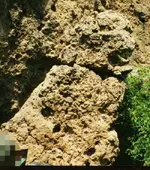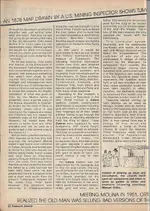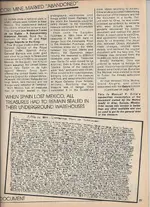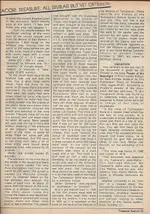Roy,
[On September 19, 1948, Mr. C. W. Walker visited Tumacacori and showed the author a location about 100 yards southeast of the mission church, on a mound which is presumably part of the unexcavated east wall of the long-abandoned Indian town. Mr. Walker picked up a few small ore and slag specimens from the top of this mound, and showed them to the writer. He then explained that in 1918 he had shipped approximately 120 tons of slag from old slag dumps adjacent to three round adobe furnaces along this stretch of high ground. He says the slag contained about 8 per cent lead, 3 per cent copper, about 8 ounces in silver, and about 1/6 ounce of gold, per ton.
There is no doubt that mining has been done in this district, and that ore was reduced on the mission grounds. The point so often overlooked, however, is that neither the exploratory trenching of 1934-5 nor the earlier activity referred to by Walker has produced any proof of structural or stratigraphic tie-in between smelting structures and mission period buildings or occupational levels. It should be mentioned, also, that the trenches covered a wide enough area, and were deep enough, to definitely disprove the idea of an "escape" tunnel from the church or patio to the river.]
First, I have no idea who C.W. Walker is. Second, there is nothing in the piece that even hints that any mining done at that location was from the mission period. And no ringing condemnation of the Jesuits for kind of activity. You have much better arguments elsewhere.
Take care,
Joe
Joe; first I don't care who C.W.Walker is, this is the name given in the published account by the Park Service. If you wish to take that issue up with them, I won't stand in your way.
Second, I don't know how you got all that out of what discussion even brought up the frigging SLAG once again, which was the BELLS.
I simply said that I don't buy it that making THREE BELLS resulted in 120 TONS OF SLAG. The slag as reported by mr Walker, had some eight ounces of silver per ton, which at least one expert has stated, is
INDICATIVE OF SILVER SMELTING and not copper or some other metal. How you got that this was some "ringing condemnation of the Jesuits" from a simple statement I do not understand.
There is slag built into two of the missions very walls. You can sure try to paint that any way you wish, but I can't see modern American miners bringing their ore to an old mission in ruins, smelting it there and then putting pieces of slag into the walls of the mission for decoration. The padres were doing this. I also do not buy it that any American or Mexican or Spaniards were at the missions smelting and casting BELLS.
Plain facts - mounds of slag were found at Guevavi and Tumacacori, slag is built into the walls of San Xavier del Bac and Tumacacori; there are a string of silver mines (and a couple gold) located in southern Arizona, attributed to the Jesuits by virtually every OLD source. The AZ state and USGS geologists stated that the presence of the slag at the missions was solid proof of the mining activities of the Jesuits. The Jesuit Order was very wealthy up to 1767 in Mexico and owned mines (plural) openly, which mines must produce the precious metals the mines were for. Very little of that output, and I include the illicit mines in Pimeria Alta referred to by father Nentvig and specifically NOT listed as Spanish owned, likewise must have produced silver and gold, which likewise has not been accounted for. Even father Segesser made statements indicating the San Xavier mission was closely associated with its own silver mines.
You can continue to try such criminal defense lawyer type tactics, but there were mines that were for over a century known as having been owned and run by the Jesuits, there is clear evidence of smelting activities at several missions, and we can not even account for three bells much less the $40,000 worth of silver seen at San Xavier.
The only reason I had posted that extract from Mr Walker (and by extension the Park Service) was that
Springfield had
wanted to know exactly how much slag there was, and it is the ONLY statement that I know of which attempts to address that question, and that only for Tumacacori and does not address Guevavi with several more mounds, or San Xavier. It was not my "best" argument concerning Jesuits and their mines, nor intended to be.
So by all means, lets talk "real history" which would be the version that you find acceptable, rather than this most distasteful and filthy topic that you see as fantasy; after all your 'opponents' in this debate are just wild-eyed treasure hunters after all, not the scholastic academics whose expertise we must not question.

Oroblanco
PS I can tell you how you could get 120 tons of slag while making three copper bells; most of the silver mines of the Jesuits also carry a certain amount of copper; the ore smelted to remove the silver, would also produce some copper, which logically then could be used to cast bells. Otherwise we have no copper mine to explain the smelting activity, and it would take an awful lot of jewelry to make church bells.






 >
>












